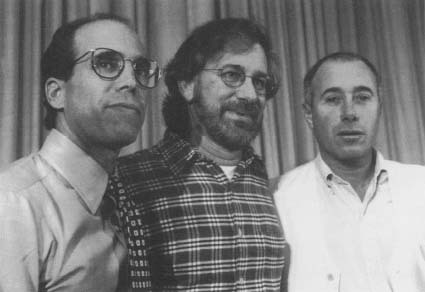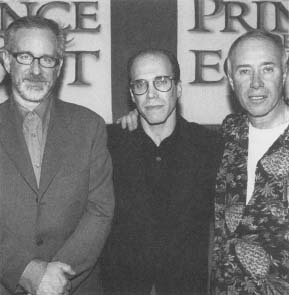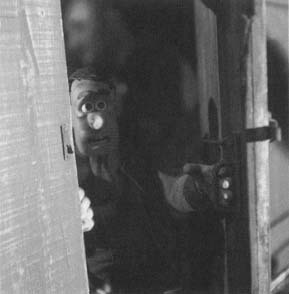DreamWorks SKG
1000 Flower Street
Glendale, CA 91201
(818) 733-7500
www.DreamWorks.com
In 1994, three of the most influential people in the entertainment world joined forces to form DreamWorks SKG. The best known was director Steven Spielberg, creator of some of the most popular films of all time. From the Walt Disney Company (see entry) came Jeffrey Katzenberg, the executive who revitalized that studio's famous animated film department. And from the music world came David Geffen. The self-made billionaire had launched several successful record companies and also produced films.
With the creation of DreamWorks, Spielberg, Katzenberg, and Geffen became the first people in sixty years to start a new film studio. But DreamWorks did not stop with films. The three men planned to produce TV shows, record music, and create video games. The boldness of their move—and the power of their personalities—caught the attention of the media and other entertainment firms. Although the company struggled at times, DreamWorks became a major force in the entertainment industry.
Building the "Dream Team"
DreamWorks may never have happened if Jeffrey Katzenberg had gotten the position he craved at Walt Disney. He had worked with Disney chief executive officer (CEO) Michael Eisner (1942-) at Paramount Pictures, then followed Eisner to Disney in 1984. At Disney, Katzenberg ran the company's movie studios; he paid particular attention to animated films.
Disney had pioneered animation in Hollywood, but by the time Katzenberg joined the company, it had not had a major animated film in years. Katzenberg helped Disney create new animated classics, including Beauty and the Beast (1991), Aladdin (1992), and Lion King (1994). Those successes, as well as good profits from live-action films, helped Disney grow tremendously under Eisner. In April 1994, Kaztenberg thought he deserved to be named company president after the untimely death of then-president Frank Wells. Instead, Eisner took on the title. An upset Katzenberg left Disney and began considering new opportunities.
Katzenberg was already a friend and business partner of Steven Spielberg. The pair owned a popular Los Angeles restaurant, Dive! Katzenberg was also close with Geffen. The two men had first met during Katzenberg's days at Paramount. Katzenberg asked the two if they were interested in forming a new entertainment company. At first, Spielberg was reluctant to end his relationship with Universal (then owned by MCA), the studio he had worked with for more than twenty years. In addition, he and Geffen had not always gotten along in the past. Geffen, who was worth more than $1 billion at the time, wondered if it was worth the trouble to start a new company and take on business partners.
DreamWorks at a Glance
- Employees: 1,500
- Principal Executives: Steven Spielberg, Jeffrey Katzenberg, and David Geffen
- Subsidiaries: DreamWorks Records; PDI/DreamWorks
- Major Competitors: Vivendi Universal; Viacom; AOL Time Warner; Walt Disney Company
- Notable Movies: Shrek; Gladiator; American Beauty; Cast Away; A Beautiful Mind; Prince of Egypt; Antz
But Katzenberg convinced his two friends the deal made sense, and on October 12, 1994, Spielberg, Katzenberg, and Geffen announced the creation of their new, still-unnamed company. Katzenberg said the three represented a "dream team" of talent. That name, plus the idea that creative people bring dreams to life, led to the name DreamWorks, followed by the first initial of each man's last name. Each one put up $33 million to start the company, and then began searching for investors and partners.
Paul Allen (1953-), one of the founders of Microsoft Corporation (see entry), invested the largest single chunk of money—$500 million. A South Korean chemical company added another $300 million. In 1995, DreamWorks and Microsoft formed a new company, DreamWorks Interactive, to make video games. Microsoft also invested directly in DreamWorks SKG.
Timeline
- 1994:
- Jeffrey Katzenberg leaves the Watt Disney Company and convinces Steven Spielberg and David Geffen to help him form a new entertainment company, DreamWorks SKG.
- 1995:
- Microsoft partners with DreamWorks to create the video game company DreamWorks Interactive.
- 1996:
- Older, by George Michael, is DreamWorks's first musical release.
- 1997:
- DreamWorks releases its first film, The Peacemaker.
- 1998:
- Antz and Prince of Egypt are DreamWorks's first animated films.
- 1999:
- Steven Spielberg wins his second Academy Award as Best Director for Saving Private Ryan, a DreamWorks co-production.
- 2000:
- DreamWorks wins the first of three consecutive Academy Awards for Best Picture with American Beauty.
- 2001:
- Shrek, a computer-generated film, is DreamWorks's most successful animated feature to date.
- 2002:
- The ABC television network announces it will not renew Spin City, DreamWorks's only hit television program.
Bad Dream?
DreamWorks announced it would not have titles for its executives, and it promised to share profits with its staff.

Geffen focused on the company's music efforts, but also used his film industry contacts to work out deals with other studios (some Dream Works's films were co-productions with other companies). Spielberg turned over the assets of his production company, Amblin Entertainment, to DreamWorks. He planned to make films and hire other directors to make films. He also, however, reserved the right to make movies for other studios.
Starting a new studio took time and money, and one year after Spielberg, Katzenberg, and Geffen formed DreamWorks, the company still did not have any products to sell. Finally, it produced several TV shows for the ABC network, but the first two, Champs and Ink, were quickly cancelled. The first DreamWorks record came in 1996, from George Michael (1963-), a singer who had not released a song in three years. Although Michael had been popular in the late 1980s and early 1990s, his DreamWorks release, Older, did not sell as well as the company hoped.
Filmmaking always seemed to be Dream Works's strongest area, and Hollywood eagerly awaited its first pictures. That release, however, did not come until the fall of 1997, with The Peacemaker. An action film starring Nicole Kidman (c. 1967-) and George Clooney (1961-), The Peacemaker cost $50 million to make, and made only $41 million in U.S. ticket sales. Spielberg's first film for DreamWorks, Amistad, was also a disappointment at the box office. During 1997, a joke in Hollywood described "the DreamWorks doll": Wind it up and it does nothing. Still, some people in the entertainment business were willing to give DreamWorks some credit. Harold Vogel, an analyst of entertainment companies, told Entertainment Weekly, "To do what they've done in three years is remarkable."
First Successes
In 1998, DreamWorks finally saw positive results on several fronts. Its TV show Spin City was a hit, and its successful films included the science-fiction thriller Deep Impact, and the computer-animated film Antz. DreamWorks also shared in the profits—and the glory—of Spielberg's Saving Private Ryan. The movie, set during World War II (1939-45) was co-produced with Paramount. Ryan earned more than $200 million in the United States and was nominated for eleven Academy Awards, the film industry's highest honor.
The DreamWorks logo shows a young boy fishing while sitting on a crescent moon. Steven Spielberg designed the logo, wanting to represent the idea of a simple company where dreams come to life.
In 1998, DreamWorks also released its first traditional (hand-drawn) animated film, The Prince of Egypt. Reviews were mixed, but the film made money and helped create a new direction in animated film. The movie offered a serious look at the biblical figure Moses. Katzenberg was actively involved in shaping the film. As he described it to the Los Angeles Times, "There's a seventy-year tradition … called fairy tales for toddlers told in

Although the record label and TV productions continued to struggle, DreamWorks had found its place with films. Still, the company was not profitable. As a privately held company, DreamWorks did not have to release its finances. The Los Angeles Times, however, reported in July 1999 that the company had lost $200 million the year before on revenues of more than $ 1 billion. But the loss, the paper pointed out, did not reflect future earnings from the hit films produced that year. And in 1999, DreamWorks continued to have success with movies. The drama American Beauty was one of the top films of the year and won the Academy Award for Best Picture. The next year, the company duplicated the achievement when Gladiator (co-produced with Universal Studios) won Best Picture along with several other Academy Awards.
No Clockwork at DreamWorks
Despite the creative and business talents of Spielberg, Katzenberg, and Geffen, DreamWorks could not guarantee that every venture it tried would work. In October 1999, the company announced a deal with Imagine Entertainment to create Pop.com , a Web site that would feature short films. One of the creative partners in the new deal was director Ron Howard (1954-), who planned to help create content for the site. But Pop.com never reached the Web, as DreamWorks killed the idea the next fall. The company also got out of the video game business, selling DreamWorks Interactive to game maker Electronic Arts in April 2000.
The Studio with No Studio
In the motion picture industry, "studio" is another name for a company that makes and distributes films. The leading studios include 20th Century Fox, Universal, and Warner Brothers. A studio is also the physical series of buildings and outdoor areas, called backlots, where films are made. When DreamWorks SKG formed, the company planned to build its own studio. Steven Spielberg was the driving force behind the idea. He hoped to construct a state-of-the-art facility for making films. David Geffen, however, was never convinced the company should pay the estimated $250 million it would cost to build a new studio.
Spielberg's plan was to build on a 47-acre lot in a new development called Playa Vista. The site once belonged to billionaire Howard Hughes (1905-1976), who built the world's largest plane, the Spruce Goose, in a hangar there. The total Playa Vista project was supposed to include stores, office space, and housing. The development, however, faced opposition from environmentalists, since Playa Vista bordered one of the last remaining wetlands in California.
Some environmentalists singled out DreamWorks for criticism, since it was the most visible company considering moving to Playa Vista. That protest, as well as rising costs for the planned studio, led DreamWorks to drop the project in July 1999. Jeffrey Katzenberg told the Los Angeles Times, "It was a very grand, exciting idea four-and-a-half, five years ago. And maybe it was just a little too grand in the end." DreamWorks remained split up between Universal Studios, offices in Beverly Hills, and its new animation studios in Glendale.
Producing popular films also continued to be a hit-or-miss business, although some of the hits were spectacular. In

In the summer of 2001, DreamWorks released a new Spielberg film, A.I.: Artificial Intelligence. The movie had disappointing sales in the United States, failing to back its production costs. But another DreamWorks release, A Beautiful Mind, did much better at the box office and gave the studio its third straight Academy Award for Best Picture. The next year, DreamWorks finally had a summer blockbuster on its hands with the release of Minority Report, a science-fiction thriller with Tom Cruise (c. 1962-).
The original deal between Spielberg, Katzenberg, and Geffen, was scheduled to last ten years. DreamWorks's future as an independent company was uncertain, but the bold experiment to build a new entertainment company led to some of the most memorable films of the last few decades.
Comment about this article, ask questions, or add new information about this topic: